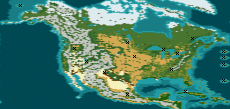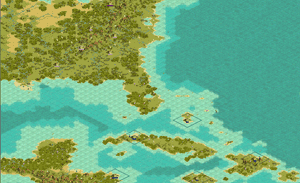The Civs: Europeans
Spain -- Easy
Gunpowder, Monotheism, Magnetism, Monarchy; Militaristic, Religious, Expansionist
The Spanish start out with plenty of Conquistadors (their unique unit) and Settlers jumping at the chance to make their fortune in the New World (5 Conquistadors, 2 Musketmen, 2 Settlers). They also start with a Frigate and a Galleon that just happens to be on the verge of landfall. Spains real strength is conquest, and one great strategy is to go after the Aztecs before they can build up plenty of very mobile defenders.
England -- Easy
Gunpowder, Monotheism, Magnetism, Monarchy; Industrious, Commercial, Expansionist
England is ready to Colonize rather than conquer, but they have a competent military and growing sea power (4 Settlers, 1 Worker, 3 Musketmen, one Trapper). They start with a Galleon and a Privateer. The British unique unit, the Man-O-War, allows you to rule the seas but does not seem to be of much use against enemies lurking in the forests.
France -- Moderate
Gunpowder, Monotheism, Magnetism, Monarchy; Scientific, Industrious, Expansionist
France is also set for colonization but is focused on the fur trade as well (2 Musketeers, 3 Settlers, 3 Trappers). They start with a Galleon. The unique Musketeers werent historically active in New France, but Trappers were not useful enough as a replacement. So Trappers can be built by all northern Civs and the Musketeers remain.
Netherlands -- Difficult
Gunpowder, Monotheism, Magnetism, The Republic; Scientific, Expansionist, Commercial
The Netherlands look to make a tidy profit through colonization and trade, but dont have the population or military resources of other countries (3 Settlers, 2 Musketmen). They start with two of their unique sea unit, the Merchantman.
Russia Difficult
Gunpowder, Monotheism, Magnetism, Monarchy; Scientific, Expansionist
The Russians look to strike a claim in North America through footholds in Alaska but are at a definite geographic disadvantage (2 Trappers, 2 Musketmen, 1 Settler). They start with a Caravel. The Russians have another disadvantage in that their unique unit, the Cossack, is not immediately available.
The Civs: Native Americans
Aztec -- Easy
Bronze Working, Ceremonial Burial, Masonry, Mathematics; Religious, Militaristic
The Aztecs occupy Central Mexico and have the most advanced Native civilization. Their large cities, road system and unique Jaguar Warriors also contribute to their success. The Aztecs also usually benefit from being left alone early by European AIs. Their large cities allow them to get a jump on building Ancient wonders, and they are associated with Chichen Itza, Colossal Olmec Heads, Temple of the Sun, and The Calendar.
Apache -- Moderate
Warrior Code, Pottery, Ceremonial Burial; Militaristic, Commercial
The Apache represent the Tribes of the American southwest. They were also some of the last to oppose the Europeans in battle. They can build both Mounted Warriors and Expert Riders, and are associated with the Ghost Dance Wonder
Nez Pierce -- Moderate
Ceremonial Burial, Pottery, Horseback Riding; Industrious, Religious
The Nez Pierce represent the native tribes of the Pacific Northwest and Columbia River basin. They took to horseback riding readily, and some traditions hold that they possessed horses since crossing over the Bering straight 10,000+ years ago. They start with Canoes and can build Mounted Warriors and Expert Riders.
Sioux -- Moderate
Ceremonial Burial, Warrior Code, Pottery; Militaristic, Expansionist
The Sioux represent the Great Plains tribes. They quickly adapted to horseback riding and held off against European/U.S. aggression very effectively. They can build both Mounted Warriors and more powerful Expert Riders.
Cree -- Moderate
Currency, Pottery, Ceremonial Burial; Industrious, Commercial
The Cree ranged from the Great Lakes to the Rocky Mountains and from the Great Plains through much of Canada. They were good traders and are one of the largest native populations today. They can build Mounted Warriors and Trappers and have Canoes.
Chippewa -- Moderate
Warrior Code, Ceremonial Burial, Currency; Commercial, Expansionist
The Chippewa occupied the area around the Great Lakes. They were good traders and sometimes got into conflict with other native tribes. They start off with Canoes and can build Trappers, Mounted Warriors, and Expert Riders.
Iroquois Moderate
Pottery, Ceremonial Burial, Code of Laws; Expansionist, Religious
The Iroquois were a confederation of tribes whose laws influenced the U.S. Constitution. They took sides in the fight between the European powers and later the U.S. They can build Mounted Warriors and Trappers. They are also associated with eh Great Serpent Mound Wonder.
Cherokee -- Moderate
Warrior Code, Pottery, Currency; Industrious, Scientific
The Cherokee represent the tribes the inhabited the Appalachian Mountains and the Southeast. They attempted to adopt European-style farming and culture but were still pushed off their territory, forced to walk the Trail of Tears. Likewise, their success in the game hinges on how long they can expand and advance with out facing a technologically superior enemy. They can build Mounted Warriors.
Arawak -- Difficult
Pottery, Currency; Religious, Commercial
The Arawaks inhabit the Caribbean islands and may have been the first natives The Europeans made contact with. They would rather trade than fight, and start off with Canoes. Their main disadvantage is widely spread, sparsely populated island territory. If the Spanish arrive on one island, dont expect to get your reinforcements quickly from cities on three others.
Micmac -- Difficult
Pottery, Currency; Commercial, Scientific
The Micmac occupied eastern Canada and were great trading partners with the French. They adopted many European ideas and many married Europeans. Their real disadvantages are low populations growth and early contact with Europe. They start with Canoes.
Ute -- Difficult
Ceremonial Burial, Pottery; Industrious, Religious
The Ute represent the native tribes of the Rocky Mountains and Great basin. Their greatest disadvantage is rocky, desert terrain and lack of trading routes, but both can be made up for by a long period before European interests turn to them. They are associated with the Pueblo City Bonito Wonder.








